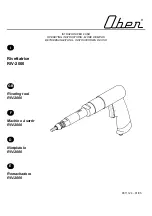
Operation and
Serial Communication Programmer’s Guide
SENTRY
™
Tool Interface Module
(TIM-100/120)
and Program Module (TIM-200)
Section 5: Serial Communication Interface Programming
12286 Rev 2
Page 1 of 5
5.1 Serial Communication Interface Programming
In order to configure equipment or host to communicate with the TIM-100/120 for adjusting a
set point or interrogating a read-back value, the equipment or computer must be programmed
to communicate with the TIM-100/120.
Only three commands are required for serial communication. They are: 1) power-up clear, 2)
exhaust (pressure or flow) set point and 3) actual exhaust (pressure or flow) read-back. This
section describes the communication commands, format and protocol required to allow the
equipment or computer to adjust the set point and report a read-back through serial
communication.
General Description
A message format and communication protocol has been established for transmitting
commands and receiving acknowledgments from the TIM-100/120. The host processor and
the TIM-100/120 have a master and slave relationship, respectively. That is, the host
processor (master) is responsible for initiating communications with the TIM-100/120 (slave).
The communication protocol requires the host to send a command to the TIM-100/120. For
each command sent, the TIM-100/120 will respond with an acknowledgment message. The
communicated commands and acknowledgments are text strings made up of characters from
the ASCII character set.
Note:
•
Up to 64 uniquely addressable TIM-100/120s can be connected on a given network.
•
Specification guidelines for RS485 provide for a maximum of 32 units, including the host,
on a single network. A repeater is required to add additional 32 units for a maximum
total of 64 SENTRY TIM-100/120s.
•
Refer to Appendix B for the serial communication specifications.
Command Description
The SENTRY Command messages consist of the following components. For a given
command, some or all of the components may be used.
•
Start of message character “>”
•
TIM-100/120 address and data bank
•
Single character command
•
Hexadecimal represented data
•
Two character checksum
•
Carriage return “
↵
”
Note:
•
The TIM-100/120 uses the hexadecimal numbering system to represent numbers in
commands and responses. SENTRY command messages are transmitted as a series
of ASCII characters. Numbers are transmitted as the ASCII number characters 0
through 9 and the upper case ASCII characters A through F.
•
Appendix E provides a decimal to hex and decimal to binary conversion table.













































